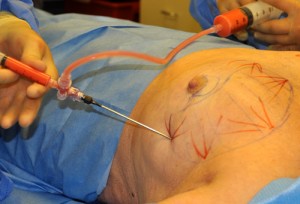Fat transfer for breast reconstruction or for cosmetic breast augmentation is a new technique that continues to evolve. There are many unresolved and unknown issues with injectable fat transplantation in general not to mention some that site-specific to the breast. One of the more important breast issues is whether fat injections can interfere with important mammographic breast screening.
In the March 2011 issue of the journal Plastic and Reconstructive Surgery, a study of breast augmentation where fat was injected as the method of volumetric enhancement reports that it doesn’t interfere with routinue screening mammograms. This study out of France concludes that radiographic follow-up of breasts treated with fat grafting is not problematic and should not be a hindrance to the procedure.

This French study was designed to determine whether such lipomodeling caused any problems with routine mammograms in the screening for breast cancer. Their findings were based on reviewing mammograms that were done an average of 16 months after breast fat injections in 31 women. In more than half of cases, the mammograms showed no abnormalities. Some women had small calcifications or cysts from the fat transfers. A few women had other abnormalities related to scarring from their breast surgery. However, none of these changes raised any suspicions for breast cancer on their mammograms. In addition, there were no major changes in breast density after fat injections. They also found that it was no more difficult to perform and interpret follow-up mammograms in breasts that had undergone the procedure.
While this first such reported study on breast fat injections is encouraging, it is important to realize that it comes from just one center and on a small number of patients. Its results should be interpreted with cautious optimism. It would be advised that women undergoing any form of breast fat reshaping have mammograms taken before and after the procedure. This will provide documentation that any new changes of the mammogram are due to the fat and not a possible sign of breast cancer.
As fat injection grafting to breasts continues to used clinically, one of the most important concerns is what that means to breast cancer detection. It is reassuring to know that such mammographic changes are not easily interpreted as suspicious. Further studies will provide more insight into qualifying how these mammographic changes appear.
Dr. Barry Eppley
Indianapolis, Indiana


